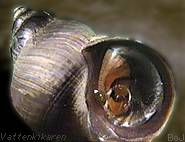 |
|

The rough
periwinkle can close its shell apeture with a horny lid known
as the operculum.
Many organisms that do not have a protective shell or case secrete
a protective mucus. |
It is relatively bad protection
against dehydration, but is utilized by certian hydroids
and anemones, for example the dahlia
anemone. The mucus is not effective enough to enable the animal
to survive the wind and sun on the bare cliffs.
Different algae need to be positioned in such a way
that they are able to collect sunlight, whilst many are lacking sufficient
protection. In spite of the fact that they can lose much water, they
have a remarkable ability of recovery. Bladder
wrack for example can recover even after losing up to 70% of its water
content. |
Protection against heat and cold
Both the cold and the heat can injure or kill
beach organisms, but it appears that most of the mechanisms that steer body
temperature are geared to avoid high temperatures. This is accomplished
in two ways:
(1) By reducing the flow of heat from the surroundings and
(2) by increasing the dissipation of heat from the body.
One way of decreasing the absorption of heat from the surroundings
is by having so little body area as possible. A spherical form has the smallest
surface area in relationship to volume, the surface area in relation to
volume also decreases with increased body size. Another factor is colour.
White absorbs less heat compared to a dark surface. Therefore, large, round,
white organisms absorb heat slowly. Because sun soaked cliffs and rocks
can be very warm, it is important to have so little
surface contact against them as posible.
 |
Page 26 of
52 |
 |
|


